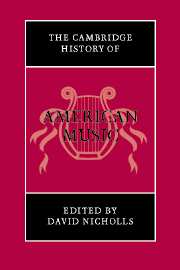Book contents
- Frontmatter
- PART ONE
- PART TWO
- 10 Music in America: an overview (part 2)
- 11 Immigrant, folk, and regional musics in the twentieth century
- 12 Popular song and popular music on stage and film
- 13 The rock and roll era
- 14 Ragtime and early jazz
- 15 Jazz from 1930 to 1960
- 16 Jazz since 1960
- 17 Tonal traditions in art music from 1920 to 1960
- 18 Serialism and complexity
- 19 Avant-garde and experimental music
- 20 Tonal traditions in art music since 1960
- Bibliography and references
- Index
- References
10 - Music in America: an overview (part 2)
from PART TWO
Published online by Cambridge University Press: 28 March 2008
- Frontmatter
- PART ONE
- PART TWO
- 10 Music in America: an overview (part 2)
- 11 Immigrant, folk, and regional musics in the twentieth century
- 12 Popular song and popular music on stage and film
- 13 The rock and roll era
- 14 Ragtime and early jazz
- 15 Jazz from 1930 to 1960
- 16 Jazz since 1960
- 17 Tonal traditions in art music from 1920 to 1960
- 18 Serialism and complexity
- 19 Avant-garde and experimental music
- 20 Tonal traditions in art music since 1960
- Bibliography and references
- Index
- References
Summary
In chapter 2, I discussed three aspects of the interaction between individualism and egalitarianism which characterizes American music as well as her politics and society: elitist art and egalitarian folk musics, which in some respects mark the poles of a spectrum, and the mediational role of musical reformers. The present chapter explores three other aspects: a counter-reform, the popular music industry, and the interlinked techniques of improvisation and experiment. I begin by returning to the reformers.
Counter-reform
The reformers sought to elevate America’s tastes by presenting artistic values in a musical language suited to ordinary citizens. They were most successful in cities, where their ideas both supported and rested on a rich concert life. The links between art music, reform, and patronage thereby grew steadily stronger, so that by the 1870s many reformers had effectively become upper-class conservatives.
By that time, however, America was becoming more self-critical about its social and economic polarities. The aesthetics of working-class citizens seemed less important than their economic position, and values derived from European art music seemed far removed from the affection citizens granted their folk and popular musics. Though reform methods still served to promote musical literacy and performance, they became increasingly irrelevant to the reformers’ original, broader objectives: mediation, reconciliation, acculturation. A counter-reform was needed.
This, like its predecessor, was grounded in religion – in particular, the unending succession of religious revivals that swept across nineteenth-century rural America. The music sung at these ranged from traditional psalms to remnants of the New England repertory to, eventually, reform hymns by Mason and his brethren.
- Type
- Chapter
- Information
- The Cambridge History of American Music , pp. 255 - 275Publisher: Cambridge University PressPrint publication year: 1998

